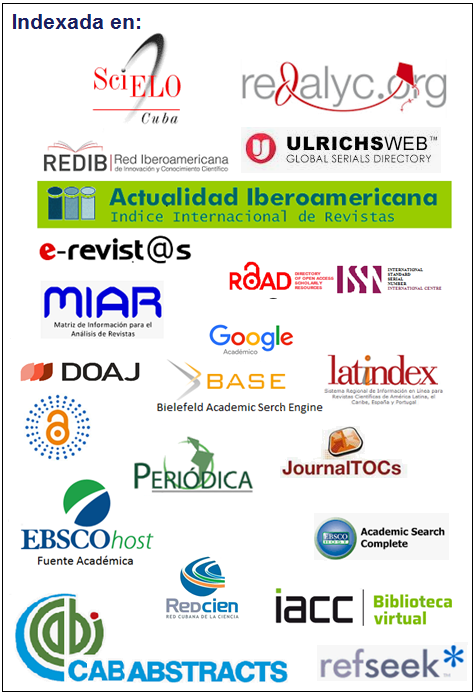Effect of solids concentration on rheology of ceramic clay hydro mixtures in the washing process
Keywords:
Rheological behavior of hydro-mixtures, ceramic clays, maximum packing fractionAbstract
The rheological study of ceramic clay hydro mixtures is essential to design equipment and washing processes. Hydro mixtures with clay concentrations of 15%, 25%, 35%, 45% and 55% by weight were analyzed and the correlation of shear stress as a function of the velocity gradient was obtained. It was observed that for concentrations up to 15%, the fluid, presents Newtonian behavior as well as ideal plastic behavior for higher concentrations. In order to estimate values of plastic viscosity, the decreasing dependence of maximum packing fraction of the mixture as a function of the clay concentration was determined. As a result, a general model is proposed for estimating the apparent viscosity of the hydro mixture during the ceramic clay washing process, which considers the clay concentration, dynamic viscosity coefficient of the hydro mixture water and the velocity gradient.Downloads
References
Angélica, R.; Rojas, A.; Garcell, L. and Pérez L. 2010: Mineralogía y reología de suspensiones minerales del proceso de lixiviación ácida a presión en Moa, Cuba. Minería y Geología, 26(4): 16-35. ISSN: 1993 8012.
Belaño, J. y Lascano, C. 2022: Diseño de un sistema SCADA para la adquisición de datos en medición de pérdidas primarias y secundarias en un sistema de flujo. Universidad Técnica de Cotopaxi. Ecuador. Consultado: 22/02/2023. Disponible en: http://repositorio.utc.edu.ec/handle/27000/9292.
Bustamante, M.; Rojas, N. and Quitian, G. 2016: Fine material effect on kaolin suspensions rheology. DYNA, 83(195): 105-111. ISSN 2346-2183 Online DOI: http://dx.doi.org/10.15446/dyna.v83n195.48855
Correa, J.; Rojas, N. and Tobón, J. 2018: Effect of fly ash and silica fume on rheology, compressive strength and self-compacting in cement mixtures. DYNA, 85(206): 59-68. https://doi.org/10.15446/dyna.v85n206.68960
Filho, J.; Sinhorelli, K. and Medeiros, G. 2020: Estudo da reologia de pastas cimentícias contendo resíduo de tijolo cerâmico moído e metacaulim. Revista materia, 25(1). ISSN 1517-7076. DOI: 10.1590/S1517-707620200001.0879.
Garcell, L. 1998: Transferencia de cantidad de movimiento, calor y masa. La Habana: Editorial, Pueblo y Educación.
Laurencio, H.; Gilbert, A. and Retirado, Y. 2017: Modelado de la viscosidad aparente de un petróleo crudo de 11°API con comportamiento no newtoniano. Ingeniare. Revista chilena de ingeniería, 25(4): 674-680. DOI: http://dx.doi.org/10.4067/S0718-33052017000400674.
Laurencio, H.; Retirado, Y.; Bautista, W.; Torres, E. and Albarracín, M. 2020: Caracterización de las propiedades mecánicas de las arcillas para tejas de barro producidas por alfareros de la parroquia la Victoria, cantón Pujilí. Revista ciencias de la ingeniería y aplicadas, 4(1): 1-11. ISSN: 2602-8255.
Leyva, B.; Guillen, Y. y Laurencio, H. 2016: Caracterización reológica de un lodo que se genera en el lavado de árido. Ingeniería Mecánica, 19(3): 143-149. ISSN: 1815-944.
Maron, M. and Martínez, L. 2015: Modelamiento y estudio del efecto de la reología del relave en canaletas. Universidad de Chile, Santiago de Chile.
Martínez, R. and Hernández, G. 2015: Caracterización reológica de pulpas de cieno carbonatado. Minería y Geología, 31(4): 70-83. ISSN: 1993 8012.
Pérez, L.; Cardero, Y.; Lamoth, Y. and Garcell, L. 2008: Estudio del comportamiento reológico de una suspensión industrial de laterita. Tecnología Química, 27(1): 22-33. ISSN: 0041-8420
Spychał, E. 2020: The rheology of cement pastes with the addition of hydrated lime and cellulose ether in comparison with selected properties of plastering mortars. Cement-Wapno-Beton= Cement Lime Concrete, 25(6): 21-30. https://doi.org/10.32047/CWB.2020.25.1.2
Zapata, J.; Meza, K.; Vega, A.; Chávez, D.; Alvarado, C.; Alvarado, A. y Vásquez, I. 2022: Ceniza de caña de azúcar: resistencia a la compresión y reología de un hormigón autocompactante. In: 20th LACCEI International Multi-Conference for Engineering, Education, and Technology. Hybrid Event, Boca Raton, Florida- USA. ISBN: 978-628-95207-0-5 ISSN: 2414-6390. (DOI): http://dx.doi.org/10.18687/LACCEI2022.1.1.308
Published
How to Cite
Issue
Section
Copyright (c) 2023 Héctor Luís Laurencio-Alfonso, Yoalbys Retirado-Mediaceja, Enrique Torres-Tamayo

This work is licensed under a Creative Commons Attribution-NonCommercial 4.0 International License.
- Authors retain copyright and guaranteeing the right magazine to be the first publication of the work as licensed under a Creative Commons Attribution-NonCommercial that allows others to share the work with an acknowledgment of the work's authorship and initial publication in this journal.
- Authors may establish separate supplemental agreements for the exclusive distribution version of the work published in the journal (eg, place it in an institutional repository or publish it in a book), with an acknowledgment of its initial publication in this journal.
- Authors are allowed and recommended to disseminate their work through the Internet (e.g., in institutional telematic archives or on their websites) before and during the submission process, which can produce interesting exchanges and increase citations of the published work. (See The effect of open access)



